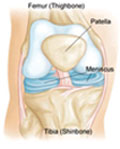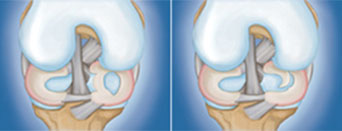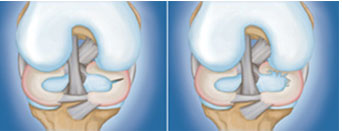Understanding the Knee Joint and Meniscal Injuries



The knee is one of the strongest joint in your body. It is made up of the lower end of thighbone, the upper end of the shinbone, and the patella or the kneecap. The ends of these bones where they touch each other are covered with a smooth covering called articular cartilage. This covering protects and cushions the bones as the knee moves through the entire range of motion. The knee joint also contains a thin lining of fluid secreting tissue called the synovial membrane which releases fluid that lubricates the cartilage and reduces friction. Bones are connected to one another by ligaments. There are four primary ligaments in your knee. They act like strong ropes to hold the bones together and keep your knee stable. The knee also contains two wedge-shaped shock absorbing gel pads called meniscus between your thighbone and shinbone. These tough and rubbery gel pads help cushion the joint and keep it stable.
- Meniscii - Two wedge-shaped pieces of cartilage act as "shock absorbers" between your thighbone and shinbone. These are called meniscus.
- Collateral Ligaments - These are found on the sides of your knee. The medial collateral ligament is on the inside and the lateral collateral ligament is on the outside. They control the sideways motion of your knee and brace it against unusual movement.
- Cruciate Ligaments -These are found inside your knee joint. They cross each other to form an "X" with the anterior cruciate ligament in front and the posterior cruciate ligament in back. The cruciate ligaments control the back and forth motion of your knee.
Causes
Common tears include bucket handle, flap, and radial depending upon how they look and their location. Sports-related meniscus tears often occur along with other knee injuries, such as anterior cruciate ligament tears.
- Squatting/Twisting the knee
- Direct contact, like a tackle
- Degenerative meniscus tears
Symptoms
- Popping Sound at the time of injury
- Pain/Stiffness/Swelling develop gradually over 2 – 3 days.
- Catching/Locking of your knee
- The sensation of your knee "giving way"
- Inability to move the knee through the full range of motion
Imaging Tests
- X-rays/Magnetic resonance imaging (MRI)
Treatment
Treatment depends on the type of tear you have, its size, and location, patient’s age, related injuries and the activity level. The outside one-third of the meniscus has a rich blood supply and a tear in this location may heal up. The inner two-thirds of the meniscus lack blood supply and tears in this zone are usually surgically trimmed away.
Nonsurgical Treatment- A small tear in outer edge of the meniscus may not require surgical repair if your knee is stable and conservative management may suffice
- Rest.
- Ice.
- ssion
- Elevation
- Pain Killers
Surgical Treatment - Surgery may be required if your symptoms persist inspite of conservative management for simple tears and in cases of complex tears and involves addressing the meniscal tears through a Knee Arthroscopy.
- Partial meniscectomy.In this procedure, the damaged meniscus tissue is trimmed away.
- Meniscus repair.Some meniscus tears can be repaired by suturing (stitching) the torn pieces together.
Rehabilitation- If you have had a meniscus repair procedure, you will need to use crutches for about a month to keep weight off of your knee. Once the initial healing is complete, your physiotherapist will prescribe rehabilitation exercises. Regular exercise to restore your knee mobility and strength is necessary. Strengthening exercises will gradually be added to your rehabilitation plan. Rehabilitation time for a meniscus repair is about 3 months. A meniscectomy requires less time for healing — approximately 3 to 4 weeks.
